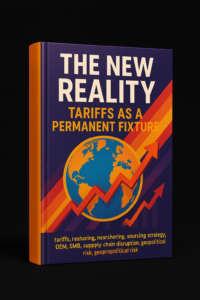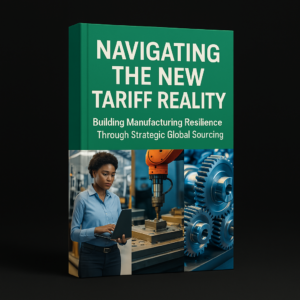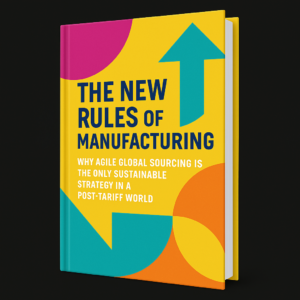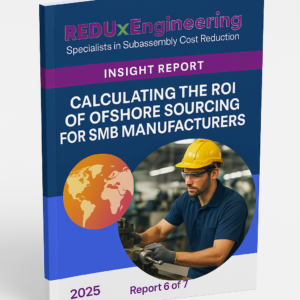
As global trade tensions escalate and tariffs become an entrenched fixture of the manufacturing landscape, one thing has become clear: there is no putting this genie back in the bottle. What began as a tactical maneuver in U.S.–China relations has snowballed into a structural transformation in global sourcing strategies. The once-standard model of sole-sourcing from China is no longer viable—not from a cost perspective, a risk management lens, or a geopolitical one.
In the words of trade historian Douglas Irwin, “Tariffs rarely go away once they are in place. They become institutionalized as part of economic policy.” This reality forces both large enterprises and SMBs to adopt flexible, resilient, and geographically diversified sourcing strategies—before they’re left behind.
The New Reality: Tariffs as a Permanent Fixture
Recent updates to Section 301 tariffs and growing bipartisan pressure in Washington signal that tariffs on Chinese imports will persist—or even expand. According to a 2025 Brookings Institution report, more than 90% of U.S. manufacturing executives now see tariffs as a “long-term business factor” rather than a temporary geopolitical tool.
For SMBs and OEMs that previously relied on China for cost efficiency and scale, the implications are sobering. Harvard economist Dani Rodrik has long warned of the vulnerability of hyper-globalized value chains: “Overexposure to a single production node in the global supply chain introduces systemic fragility.” These vulnerabilities are no longer hypothetical—they’re playing out in real time across boardrooms, factory floors, and logistics networks.
Current Strategic Shifts in Global Sourcing
Here’s what’s happening behind closed doors at board tables across North America and Europe:
-
Sole-Sourced China Strategies Are Rapidly Being Abandoned
Organizations that built their supply chains around low-cost Chinese manufacturing are urgently seeking diversification. Vietnam, India, Indonesia, and parts of Eastern Europe are emerging as favored alternatives. But this shift is not turnkey—it requires engineering input, compliance alignment, and rapid vendor onboarding. -
Global Sellers Are Seeking Tariff-Free Assembly Zones
Many manufacturers shipping into the U.S. are adopting a “less-than-49% subassembly” strategy—outsourcing key components offshore while assembling the final product in a lower-tariff zone like Mexico or Malaysia. This hybrid approach allows compliance with Rules of Origin requirements while maintaining cost competitiveness. -
U.S. Exporters Are Embracing Full Offshore Strategies
For American companies selling to Europe, Asia, or Latin America, onshore manufacturing risks triggering retaliatory tariffs. Instead, many are exploring complete offshore production with drop-ship capabilities to bypass these international trade penalties. -
Reshoring is Limited by Capacity and Cost
The recent uptick in domestic reshoring, while politically appealing, runs into hard constraints. Labor costs in the U.S. remain 4–10x higher than key offshore markets. More importantly, reshoring is rapidly consuming the limited available capacity of local contract manufacturers. As competition for domestic suppliers intensifies, prices rise, lead times stretch, and quality often suffers. As noted by Boston Consulting Group (2025), “The onshoring premium may soon erase the benefits of tariff avoidance.”
What’s Next? Agility and Diversification are the New Imperatives
What’s clear is that global manufacturing has entered a new era. As McKinsey & Company outlines in its 2024 “Resilience in Manufacturing” report, the most successful companies are shifting from efficiency-optimized to resilience-optimized supply chains. That means fewer single points of failure, more geographic flexibility, and the ability to pivot sourcing strategies rapidly in response to geopolitical shifts, cost shocks, or regulatory changes.
But for many SMBs and even mid-sized OEMs, building such an agile system internally is resource-prohibitive. Vendor qualification processes alone can take months. Regional compliance adds another layer of complexity. And global supplier audits often require travel, language skills, and technical expertise few in-house teams possess.
A Managed Model for Agile Global Sourcing
This is where REDUxEngineering enters the conversation—not as a broker, but as a fully managed, engineering-led sourcing partner. REDUx provides contingency-based offshore sourcing backed by a pre-vetted network of advanced manufacturers across tariff-favorable regions. The service goes far beyond introductions, offering:
-
Site-audited, pre-qualified vendors across Asia, LATAM, and EMEA
-
Engineering cost-outs and DFM (Design for Manufacturing) optimization
-
Integrated logistics, shipping, and inspection oversight
-
Rapid sourcing pivots with minimal operational disruption
As former World Bank lead economist Justin Lin emphasizes, “Manufacturing competitiveness is no longer just about labor cost arbitrage. It’s about innovation in process, resilience in structure, and strategic geographic alignment.” REDUx’s model aligns directly with this modern mandate—offering both strategic advantage and operational simplicity.
A Path Forward: Resilience by Design
In a volatile trade landscape, waiting for policy clarity is no longer an option. What manufacturers need today is a forward-looking strategy rooted in diversification, agility, and proactive cost management. As global policy commentator Fareed Zakaria recently remarked, “Decoupling is no longer just rhetoric—it’s the new default.”
For SMBs and OEMs that act now, the reward is not just continuity—it’s competitive advantage. They will emerge from this tariff turmoil leaner, more resilient, and with a supply chain tuned for the uncertainty of tomorrow.
Let’s have a strategic discussion. REDUxEngineering offers no-cost initial consultations and contingency-based solutions designed for leaders who can’t afford to wait for clarity. Whether your challenge is compliance, cost, or complexity—there is a structured, proven way forward.
Bibliography
-
Irwin, Douglas A. (2023). Clashing Over Commerce: A History of US Trade Policy. Harvard University Press.
-
Brookings Institution (2025). The New Normal: Tariffs and the Long-Term Supply Chain Outlook.
-
Rodrik, Dani (2022). Straight Talk on Trade: Ideas for a Sane World Economy. Princeton University Press.
-
Boston Consulting Group (2025). The Limits of Onshoring: When Local Isn’t Lean.
-
McKinsey & Company (2024). Resilience in Manufacturing: How to Pivot in a Volatile World.
-
Lin, Justin Yifu (2024). Industrial Policy and Development. World Bank Publications.
-
Zakaria, Fareed (2025). “Decoupling Is No Longer a Debate.” CNN Global Briefing.
-
World Trade Organization (2025). Global Value Chain Development Report.
-
Deloitte Insights (2024). Global Manufacturing Competitiveness Index.
-
REDUxEngineering. (2025). Company Overview and Services. https://reduxengineering.com/
#GlobalSourcing #TariffStrategy #ManufacturingResilience #SupplyChainOptimization #TradePolicy #ChinaPlusOne #DiversifySourcing #OEMStrategy #ManufacturingInnovation #GeopoliticalRisk #Nearshoring #ReshoringReality #SupplyChainDisruption #REDUxEngineering #EngineeringLeadership






